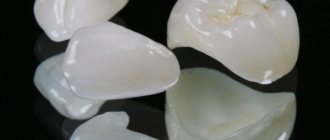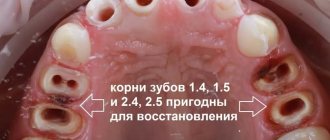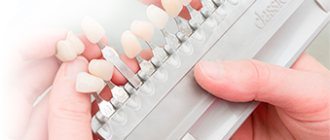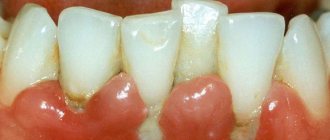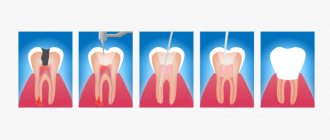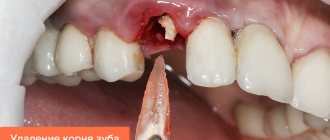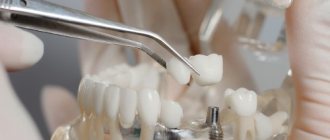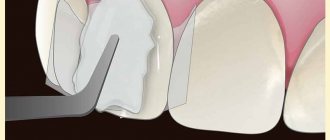Clients periodically come to the clinic with this question. The answer cannot be unambiguous; it all depends on the situation, the condition of the tooth, the root canals, and the remaining intact walls of the tooth (on the other hand). You can save a tooth in different ways: put a high-quality filling, make an inlay and a crown. The third option is the most deplorable - removing the remains of the tooth, but it is only suitable if the wall of the tooth has broken off much below the level of the gum and there is nowhere to attach the crown.
Why Teeth Chip – Potential Causes of Injury and Crown Failure
Enamel is considered the hardest tissue in the body. But even chips can appear on it, and there are many possible reasons for this. A chip is an injury in which the integrity of the crown is compromised. The damage may be very minor, even unnoticeable. But in other cases, the chip affects not only the enamel, but also the dentin.
If a tooth breaks off near the gum, such a defect cannot be ignored. Moreover, in case of large-scale damage, the pulp may also be injured, and this will inevitably provoke severe piercing pain - you need to see a doctor as soon as possible.
A chip is an injury in which the integrity of the crown is compromised
As a rule, teeth are injured as a result of mechanical impact. For example, the front incisors and canines are at high risk - they can easily be damaged if you fall or get hit. Molars more often chip off during meals, when chewing solid foods. A cracker, a fish bone, or, for example, a nut shell can injure the chewing crown. However, there are other reasons that can provoke such trouble:
- insufficient hygiene, abundant plaque and hardened deposits - the active activity of pathogenic microorganisms in this case leads to the gradual destruction of hard tissues, the development of caries and pulpitis,
- the habit of biting off thread with teeth, cracking nut shells, gnawing seeds,
- demineralization of enamel - as a result of systemic failures within the body, hormonal changes, pathological and age-related changes,
- incorrect bite – leads to uneven distribution of the chewing load, which causes crowns to wear down and chip, which are subject to increased pressure,
- consequences of dental treatment - after depulpation, that is, removal of the nerve, the tooth becomes “dead”. This means that it is deprived of constant replenishment, which is why it darkens and becomes brittle. Therefore, chips on pulpless incisors and molars are not uncommon.
Improper dental treatment can cause a problem.
If the enamel is healthy and strong, it will be quite resistant to mechanical stress, temperature and chemical factors. But if the top protective layer has weakened due to constant traumatic exposure, sudden temperature changes in food and drinks, hormonal imbalances, deficiency of vitamins and microelements, or systemic pathologies, it will be more susceptible to cracks and chips.
How to tell if a tooth is cracked
When a tooth cracks, patients notice a click. However, it is not always possible to see a crack with the naked eye, and pain often appears later. If a tooth is cracked and puts pressure on the gum, soft tissue swelling occurs and inflammation develops.
Bacteria enter the pulp through destroyed enamel. Patients note increased sensitivity to hot/cold foods and complain of pain when closing their jaws. Bad breath appears in the absence of caries. When chewing, the crack enlarges and, without treatment, leads to a tooth fracture or provokes severe pain due to nerve damage.
Important! A brown or black crack on a tooth indicates that food debris and bacteria have entered deep into the crown. Even damage to the enamel that is not noticeable at first leads to the development of caries.
Types of chips and characteristic symptoms
Experts in the field of dentistry distinguish several types of chips, which differ from each other in the nature and depth of damage. An enamel chip is a minor violation of the integrity of the crown, for example, when a small piece of the cutting edge breaks off. With such damage, patients usually do not experience pain or even discomfort. But such a defect may well affect the aesthetics, especially if it falls into the smile zone. In addition, if you ignore the problem, the tooth will continue to decay over time.
Dentin damage is usually diagnosed when the wall of a tooth near the gum, a piece of an incisor, or even half of a crown breaks off. It is much more serious if a deep chip affects a large part of the crown or, for example, leads to its vertical fracture. In this case, the person inevitably faces severe pain, and emergency dental care is required. If the root is damaged, complete removal will have to be carried out.
The photo shows damage to the dentin of the tooth.
What can you do before visiting the dentist?
Even if the damage is minor, it is better to consult a dentist as soon as possible. The integrity of the tooth must be restored, otherwise the hard tissues will continue to deteriorate. Sooner or later, a tiny chip will lead to the development of caries and significant destruction of the crown.
If we are talking about a serious injury, it is better to see a specialist as soon as possible. Here's what you need to do right away if a tooth breaks off near the gum:
- rinse your mouth with water to remove small food particles and enamel fragments,
- briefly apply ice to the cheek on the side of the sore spot, wrapped in a few napkins - this will help reduce swelling and relieve pain,
- in case of bleeding, apply a sterile gauze swab to the wound,
- Take a painkiller tablet if symptoms are severe.
Before going to a specialist, you can take painkillers.
If there are significant injuries to the baby incisors and molars, the first thing you need to do is try to calm the child down and ask him to rinse his mouth with boiled water at room temperature. Immediately after this you need to urgently go to the doctor.
How to restore a broken tooth?
What to do if a tooth is broken in half vertically?
If the wall of a tooth is broken, the dentist tries to save one of the roots if there is a fracture of a molar that has several processes. To do this, root canal treatment is performed and removal of the appendage, which cannot be saved. Next, a crown is installed in place of the broken tooth wall.
What to do if a tooth is half broken?
If a tooth is broken in half and the chip is horizontal, the doctor evaluates the condition of the tooth and root system. A broken tooth can be repaired using composite resin for minor chips or removed for significant decay. After removing the unit, the dentist prescribes an implantation procedure with the installation of a pin.
What to do if a tooth breaks but the root remains?
If a tooth is broken and the root remains in the gum, based on x-ray data, a decision is made to preserve or remove the root.
When removing the root, the dentist offers two options for restoring the unit:
- dental implantation with the installation of a titanium pin;
- installation of adhesive bridges under a broken tooth with micro-locks on the back walls of supporting teeth.
If the size of the preserved stump is at least 3 mm, and the thickness of the remaining tooth walls is at least 1 mm, restoration is carried out using:
- filling and covering with a crown to restore the anatomical structure;
- restorations by implanting a fiberglass pin, filling and installing a crown;
- stump inlay covered with a crown.
What can you do if your front tooth is broken?
If the front tooth is broken in half, in the presence of a base, the doctor performs a build-up that will not only restore the functionality of the unit, but also restore the aesthetic appearance of the smile.
This restoration method is only possible when the broken front tooth is not affected by caries. In other cases, prosthetics are prescribed. Ask us your question DIRECTLY!
+7
DECIDE! They will definitely help you here!
What to do if your front tooth is broken at the root?
If a front tooth is broken at the root, the dentist always uses the most gentle techniques possible and tries to save the tooth if possible.
When is a tooth and root removed?
A broken wisdom tooth and a broken back tooth that is not involved in chewing processes are subject to removal. Doctors recommend removing a broken tooth if part of the hard tissue and root system is damaged, there are pronounced putrefactive processes and there is no possibility of restoring the tooth. The root subject to inflammatory and putrefactive processes, as well as the broken root of the front and chewing tooth, which cannot be restored, must be removed. The procedure is carried out using ultrasound after opening the gums. In difficult cases, the root is divided into several parts and then removed. After removing the broken tooth, a crown is installed.
Prevention
To prevent tooth fracture, specialists at the Partner-Med dental clinic recommend following the following prevention methods:
- undergo an annual dental examination;
- promptly treat caries and other dental diseases;
- Healthy food;
- replenish calcium deficiency with a course of vitamin-mineral complex;
- brush your teeth twice a day;
- After eating baked goods and sweets, rinse your mouth with clean water.
A broken tooth is a problem that anyone can face. Dentists at the Partner-Med clinic will help you choose the most gentle option for treating and restoring a broken tooth.
Request a call back or dial our number!
+7
This phone call does not obligate you to anything. Just give us a chance and we will help you!
Just pick up the phone and call us!
+7
We will definitely make you an offer that you cannot refuse!
Restoration methods in dentistry
The depth of damage directly affects the choice of methods of treatment and restoration of the tooth. So, if we are talking about large chips right up to the gums, you can consider the following options for solving aesthetic and functional problems:
- artistic restoration (direct composite veneers) – a specialist restores the shape of the crown by layer-by-layer application of a light-curing composite material, exactly the same as that used for light fillings. This is the best option if the chip is located near the gum, but does not affect most of the tooth,
The defect can be corrected by installing a light-composite material - restoration tab – you can restore the shape using the tab, among other things. Essentially, it is a large filling that is made from impressions in a laboratory. It replaces part of the crown, thereby restoring its shape and functionality,
- veneers and lumineers - the possibility of using this method should be considered based on more accurate characteristics of the clinical picture. In some cases, it is impossible to hide large defects with thin ceramic or zirconium plates. Veneers and ultra-thin lumineers are usually used to completely transform your smile. With the help of such plates you can successfully disguise minor external flaws and make your smile perfect. But before installing such onlays, you will have to grind off the enamel layer in order to preserve the anatomical parameters of the teeth. However, lumineers allow you to do without this procedure, since their thickness is only 0.3-0.4 mm1,
Veneers can be used to treat this type of damage. - artificial crown - if the visible part is almost completely destroyed, it will be necessary to install a crown, possibly with the preliminary installation of a pin or stump tab to strengthen the connection of the prosthesis with the root system. Well, if, on top of everything else, the root is seriously damaged and requires removal, then the next best solution would be to install a crown on the implant. As an alternative, one can also consider bridge-like prosthetics based on row elements adjacent to the defect.
“I had this happen. One tooth on the upper jaw first chipped. It wasn’t noticeable, I didn’t feel any pain either, so I decided it was nothing to worry about. After a couple of months I ate nuts, bit poorly, and in the end the half tooth was gone! I had to get a crown, but the doctor said it wouldn’t be possible to build it up. True, he was initially dead for me, but it’s still a shame.”
Alexey, from correspondence on the 32top.ru forum
In all these cases, appropriate treatment is carried out first. In case of chips and cracks in the enamel, it is worth undergoing an examination to determine the condition of the enamel layer. Perhaps the doctor will consider it necessary to prescribe a course of fluoridation and remineralization to strengthen it.
If the pulp is seriously affected, it is likely that it will have to be removed. Partially or completely - depends on the depth of the damage. This is a neurovascular bundle that provides nutrition and vital activity to the crown. Without the nerve, it darkens, becomes brittle and breaks down faster. After depulpation, the canals are also treated and filled, and a pin or stump inlay can be installed.
What complications can there be?
Sometimes patients deliberately postpone visiting a doctor if the injury does not cause them the slightest discomfort. After all, a defect may not be too noticeable, but this does not mean that it can be ignored. Hard tissues will continue to deteriorate, and soon, in such conditions suitable for this, active pathogen activity will begin. Then caries, pulpitis, periodontitis - at this rate, after a while you can lose a tooth.
There are other consequences too. For example, sharp carved crowns can injure the inner surface of the cheeks, which can lead to infection through scratches and the development of chronic stomatitis. Therefore, the problem cannot be ignored, even if the damage is minor and does not in any way affect the appearance of the smile. The sooner you see a doctor, the easier and faster the doctor will be able to eliminate the defect.
What can be done for prevention
No one is immune from accidental injuries, but if the enamel is strong and the teeth are healthy, the chances of avoiding serious damage will be much higher. Therefore, for prevention, it is important to maintain oral hygiene and visit the dentist every six months for prevention and professional cleaning of plaque. It is worth reducing the consumption of sugar and simple carbohydrates, which contribute to the growth of bacteria in the oral cavity and the development of caries.
Excessive consumption of sweets can lead to tooth decay
On a note! If the enamel has thinned and become sensitive, be sure to consult a specialist. To restore it, fluoridation and remineralization procedures can be prescribed - hard tissues are coated with fluoride-containing compounds to nourish and strengthen them.
Enrich your diet with vegetables and fruits, seafood high in fluoride and calcium. Do not bite the seeds or try to crack the nut shell - treat your teeth with care and, if possible, eliminate all traumatic factors. Remember that if you have problems with your bite, it is better not to delay orthodontic treatment, and if any suspicious symptoms appear, you should immediately consult a doctor.
1Magne, P. Adhesive ceramic restorations of anterior teeth, 2012.
Why do pieces of teeth break off?
There may be several reasons why a piece of tooth broke off:
- Mechanical injury - blows and bruises, eating too hard or viscous food. In addition, the bad habit of gnawing hard objects (nails, pens, seeds, etc.) can lead to injury.
- A change in the normal acid-base balance in the mouth, leading to destruction or thinning of the enamel.
- Demineralization of enamel, which occurs as a result of poor nutrition or disruption of the normal hormonal levels of the body (during pregnancy, thyroid diseases, diabetes, etc.).
- Bite defects.
- Incorrect or excessive functional loads on the jaw, arising from abnormal position of teeth in a row or for other reasons.
- Carious lesions of dental tissues.
- Non-carious defects leading to the destruction of enamel - for example, wedge-shaped defect or hypoplasia.
- Incorrectly installed seals.
- Bruxism (teeth grinding).
Regardless of what caused the chipping, you must immediately contact your dentist - the doctor will help you determine exactly why pieces of teeth are breaking off and eliminate both the cause and its effect.
